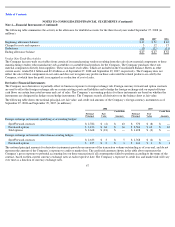Apple 2008 Annual Report Download - page 66
Download and view the complete annual report
Please find page 66 of the 2008 Apple annual report below. You can navigate through the pages in the report by either clicking on the pages listed below, or by using the keyword search tool below to find specific information within the annual report.
Table of Contents
NOTES TO CONSOLIDATED FINANCIAL STATEMENTS (Continued)
Note 1—Summary of Significant Accounting Policies (Continued)
realized by following the ordering provisions of the tax law. In addition, the Company accounts for the indirect effects of stock-based
compensation on the research tax credit, the foreign tax credit, and the domestic manufacturing deduction through the income statement.
Further information regarding stock-based compensation can be found in Note 6, “Shareholders’ Equity,” and Note 7, “Stock-Based
Compensation.”
Income Taxes
In accordance with SFAS No. 109, Accounting for Income Taxes , the provision for income taxes is computed using the asset and liability
method, under which deferred tax assets and liabilities are recognized for the expected future tax consequences of temporary differences between
the financial reporting and tax bases of assets and liabilities, and for operating losses and tax credit carryforwards. Deferred tax assets and
liabilities are measured using the currently enacted tax rates that apply to taxable income in effect for the years in which those tax assets are
expected to be realized or settled. The Company records a valuation allowance to reduce deferred tax assets to the amount that is believed more
likely than not to be realized.
During 2008, the Company adopted the Financial Accounting Standards Board’s (“FASB”) Financial Interpretation No. (“FIN”) 48, Accounting
for Uncertainty in Income Taxes
—an interpretation of FASB Statement No. 109 . FIN 48 changes the accounting for uncertainty in income taxes
by creating a new framework for how companies should recognize, measure, present, and disclose uncertain tax positions in their financial
statements. Under FIN 48, the Company may recognize the tax benefit from an uncertain tax position only if it is more likely than not the tax
position will be sustained on examination by the taxing authorities, based on the technical merits of the position. The tax benefits recognized in
the financial statements from such positions are then measured based on the largest benefit that has a greater than 50% likelihood of being
realized upon settlement. FIN 48 also provides guidance on the reversal of previously recognized tax positions, balance sheet classifications,
accounting for interest and penalties associated with tax positions, and income tax disclosures. See Note 5, “Income Taxes” for additional
information, including the effects of adoption on the Company’s Consolidated Financial Statements.
Earnings Per Common Share
Basic earnings per common share is computed by dividing income available to common shareholders by the weighted-average number of shares
of common stock outstanding during the period. Diluted earnings per common share is computed by dividing income available to common
shareholders by the weighted-average number of shares of common stock outstanding during the period increased to include the number of
additional shares of common stock that would have been outstanding if the potentially dilutive securities had been issued. Potentially dilutive
securities include outstanding stock options, shares to be purchased under the employee stock purchase plan, and unvested restricted stock units
(“RSUs”). The dilutive effect of potentially dilutive securities is reflected in diluted earnings per share by application of the treasury stock
method. Under the treasury stock method, an increase in the fair market value of the Company’s common stock can result in a greater dilutive
effect from potentially dilutive securities.
63
























